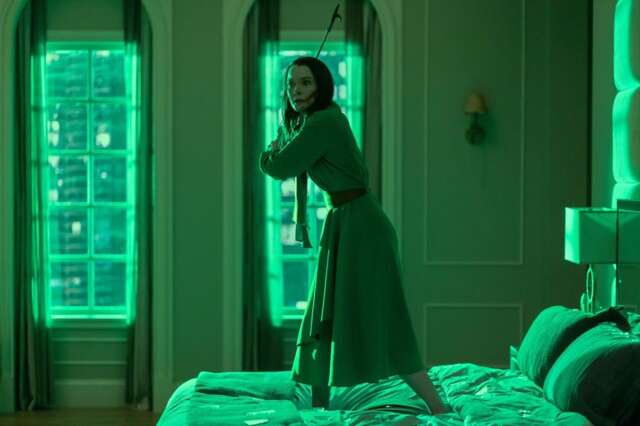The 9 Edgar Allan Poe Stories You Should Read Before Fall Of The House Of Usher
Horror maestro Mike Flanagan (The Haunting of Hill House, Midnight Mass) is bringing us to somewhere both newer and older with his latest show, The Fall of the House of Usher. Set in the modern day and connected to some real-world issues, The Fall of the House of Usher follows the Usher family and their corporation, Fortunato Pharmaceutical. While all the episodes are connected, though, they're based on separate stories by legendary American poet and author Edgar Allan Poe. Each episode--with one exception--is named after one of Poe's stories, with many of them find ways to closely follow the plot of those original stories with a modern spin. The one deviation is the first episode, titled, "A Midnight Dreary." This, obviously, is a reference to Poe's poem "The Raven," which is also the name of the final episode. This gallery does not contain direct spoilers for the Netflix series. However, if you consider details about 180-year-old stories to be spoilers, this is your warning.
1. "The Fall of the House of Usher" (1939)
While there isn't an episode with this title, it is the name of the show. Still, despite exploring similar ideas and sometimes even using the same names, Poe's different poems weren't particularly connected. Flanagan uses the idea of the Usher family, a wealthy family in ruins, as a uniting concept across all the episodes. This short story follows Roderick Usher, the last surviving member of the Usher family, who has called for an unnamed narrator--Roderick's friend--to visit him. By the time the friend arrives, Roderick's sister Madeline has already died. Roderick's paranoia grows throughout the story despite his friend's attempts to calm him, believing that his own fate is connected to the very house they stand in. The friend regales Roderick with fictional tales, but as he does so, they begin to hear noises in the house that match those in the stories. Roderick reveals that his sister, who has an illness that puts her in a catatonic, death-like state, was entombed still alive. Madeline, furious and bloody from her escape from her tomb, attacks her brother. As the narrator escapes the house, the building cracks in half and collapses into the lake behind it.
2. "The Masque of the Red Death" (1842)
This story follows a young Prince named Prospero, who is attempting to avoid a fast-acting plague called the Red Death. To amuse himself, Prospero holds a masquerade ball with 1,000 other nobles who have been holing up in the same abbey as himself. Each of seven rooms of the masquerade is decorated and lit in a specific color, with the last room decorated in black but lit in red. A black grandfather clock stands in the center of that room and chimes each hour. At midnight, a figure in a dark robe and mask appears at the party, dressed to resemble the markings of the plague. When the figure gazes upon Prospero, he screams and dies of fright. The other guests unmask the figure, only to find that there is nothing underneath--the figure was the plague itself, which spreads quickly through the crowded rooms.
3. "Murder in the Rue Morgue" (1841)
The original story, titled "The Murders in the Rue Morgue" introduces us to a man named C. Auguste Dupin, who solves the titular mystery. In the show, he takes the place of the unnamed narrator from "The Fall of the House of Usher." Notably, Dupin precedes fictional detective Sherlock Holmes by almost 50 years. The story, told again by an unnamed narrator, recounts his meeting with Dupin and how they learn of the murders of Madame L'Espanaye and her daughter Camille. The two were found maimed, with the mother's body in their home's backyard and Camille's stuffed up a chimney. The murders occurred in a fourth-floor, locked room. Following the clues, Dupin deduces that the women were murdered not by a man but by an "Ourang-Outang." In today's parlance, of course, that's an orangutan, which a sailor had brought back from Borneo. This is a pretty early example of a whodunit mystery, featuring an investigator specifically employing logic and reasoning to solve a mysterious crime.
4. "The Black Cat" (1843)
The Black Cat is a story told from the first person by the person experiencing it--again an unnamed narrator, but time more than a bystander. The storyteller talks about he and his wife's longtime love of animals, including a black cat named Pluto. While the narrator loves the cat at first, his drinking turns him on the animal, and he begins to mistreat it, causing the cat to bite him. Fueled by alcohol and rage, the narrator kills the cat. Later, the narrator adopts another black cat out of guilt, but comes to fear the cat. When his wife attempts to stop him from killing it, he kills her and hides her body. When the police come to investigate, they find the wife's body inside the wall with the cat sitting atop her head.
5. "The Tell-Tale Heart" (1843)
This tale follows a narrator beset by a disease that he says causes "over-acuteness of the senses." The narrator lives with an old man with a clouded, blue eye that he finds visually upsetting enough that he begins to plot a murder (despite feeling that the man never wronged him). After a week of decaying sanity, the narrator attacks and kills the old man. The police come to investigate after reports of the old man's screams. The man, feeling he's committed the perfect crime, invites the police in. As they talk, though, he hears a ringing that turns into an increasingly loud heartbeat. Unable to ignore it and believing that the police can also hear it, the narrator eventually confesses, revealing the old man's dismembered body beneath the floorboards.
6. "Goldbug" (1843)
The formerly-wealthy William Legrand comes into possession of a gold-shelled bug that he believes to be literally made from gold. Legrand's mental state decays and his black servant, Jupiter, asks a friend--the narrator--for help. Legrand takes them to a spot that he believes will restore his fortune. Incredibly, after dropping the insect through a skull nailed to the tree, the trio digs up a fortune that would be worth tens of millions in today's money. Legrand explains that when they found the bug, he wrapped it in a piece of paper that used invisible ink, becoming exposed when brought near heat. Incredibly, no one dies in this story. This story was one of Poe's most popular at the time of publishing, and featured a cryptogram that, when decrypted, would reveal the riddle that led Legrand to the treasure.
7. "The Pit and The Pendulum" (1842)
You probably weren't expecting to hear about the Spanish Inquisition in this article--no one ever does. In this story, our narrator is accused of and summarily convicted of crimes by the Inquisition. After fainting, he finds himself in a barely lit cell adjacent to a pit. The narrator faints again, and awakens strapped to a frame above which is a swinging pendulum blade. In the story, the narrator is able to escape by cleverly attracting rats to his bindings with food, and gets out from under the swinging blade just in time. The walls become hot to the touch and begin to close in--did the Spanish Inquisition have hot walls? We're unsure. Just in time, though, the walls stop and he's pulled from the edge of the pit to safety, learning that the French Army has arrived and deposed the Inquisition in the city.
8. "The Raven" (1845)
This poem is probably Poe's best-known work in the modern age. The man in the tale is trying to take his mind off of the death of his lost love, Lenore, by reading old stories. A raven begins to tap at his window, and when he lets it in, it perches above him and says "Nevermore." The narrator's thoughts begin to spiral, turning back to Lenore, and toward his own death and soul, with the raven replying "Nevermore" to each of his questions. Notably, this was not his first poem to feature a woman named Lenore--he wrote one in 1831 named "A Paean," about Lenore, and it was renamed to "Lenore" in 1843.
Bonus: "The Narrative of Arthur Gordon Pym of Nantucket" (1838)
Pym's tale is not an episode of The Fall of the House of Usher, but it does feature a character who figures prominently into the show. It's also Poe's only complete novel. The story follows the titular character, who stows away aboard a whaling ship. Throughout the story, Pym encounters all manner of misfortune as he travels the world, including mutiny and cannibalism. The story ends abruptly after Pym and another man see a huge shrouded figure in the mist, and has a postscript from the editors explaining that Pym died and that the final chapters were lost.
|














